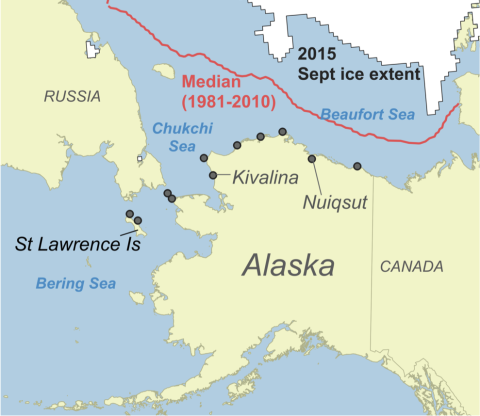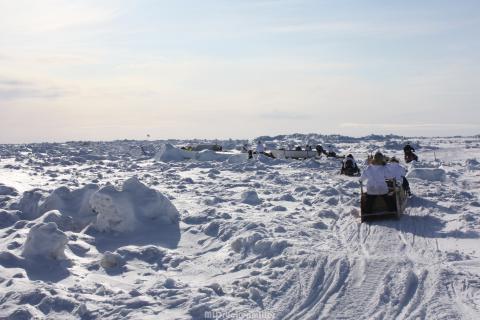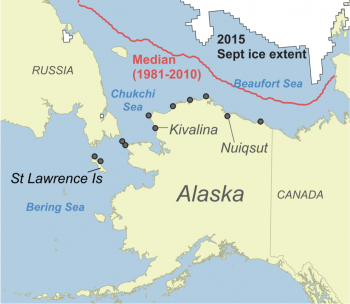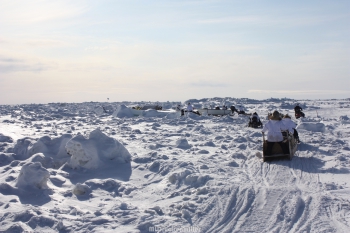

The Issue
Loss of sea ice, thawing permafrost, reduced snow cover, and rising sea level are reducing hunting and fishing opportunities and degrading infrastructure for rural Arctic communities. Most Alaska Native communities are affected by erosion and flooding, with 31 communities imminently threatened and 12 planning to relocate. Local responses to these stresses are hampered by the nation’s highest prices for food and fuel and widespread poverty across rural Alaska.
Why It Matters
Climate change amplifies challenges confronting Arctic communities, where 60-80% of households depend on wild game and fish for food, harvesting several hundred pounds per person annually. Already faced with economic, social, and cultural changes, traditional ways of life in rural Alaska are further threatened by climate change impacts on diminishing food security, deteriorating water and sewage systems, increasing risk of accidents, and greater expenditures to construct and maintain infrastructure. Government agencies and other institutions need to promote policies that reduce stresses on Arctic communities and foster responses consistent with local economies and cultures.
State of the Science

Arctic communities and scientists have worked together to document local observations of climate change; the associated impacts on hunting, fishing, safety, and food security; and the potential impacts of projected changes into the future. More recently, researchers have been assessing the efficacy of local responses. For example, subsistence whalers on St. Lawrence Island in the Bering Sea have initiated a fall harvest to help make up for spring whaling seasons made shorter by changing ice conditions. At Kivalina—a village that is also facing relocation due to erosion—changing spring ice conditions have prevented the harvest of bowhead whales for over 20 years. In other cases, changes can amplify one another. Limited time off from jobs means that whalers from Nuiqsut now have much shorter time available for whaling in fall. In Alaska's Arctic region, 78% of Native Iñupiat households combine jobs and subsistence to meet their economic, cultural, and nutritional needs. The benefits of employment are lessened, however, by the reduction in time devoted to harvesting wild foods. Less time to hunt means less chance to wait out fall storms or to adapt to other changes in weather or animal migration patterns. Those migration patterns may be further altered as diminishing sea ice opens opportunities for industrial activities (for example, shipping and offshore petroleum development). The cumulative effects of stresses and changes are broadly recognized but difficult to measure.
Where the Science is Headed

More work is needed to understand how local responses can be effective (such as the St. Lawrence Island fall whaling season) as well as how how they fall short of what is needed (such as Kivalina's inability to hunt in spring). In addition, future research must address ways that policies exacerbate or mitigate such impacts, for example by imposing additional constraints on what communities can do, or by supporting flexibility and local initiative to solve problems. Actions made without adequate knowledge of local conditions, no matter how well intentioned, may undermine local well-being by promoting ineffective responses or fostering dependence on outside intervention rather than on local talent, capacity, and creativity. Ultimately, communities need support to identify local solutions.
Further Reading
Chapin, F.S., III, S.F. Trainor, P. Cochran, H. Huntington, C. Markon, M. McCammon, A.D. McGuire, and M. Serreze, 2014. Ch. 22: Alaska. Climate Change Impacts in the United States: The Third National Climate Assessment, J. M. Melillo, Terese (T.C.) Richmond, and G. W. Yohe, Eds., U.S. Global Change Research Program, 514-536. doi:10.7930/J00Z7150. [Available online at: http://nca2014.globalchange.gov/report/regions/alaska]
Goldsmith, S., 2008. Understanding Alaska's Remote Rural Economy, UA Research Summary No. 10, Institute of Social and Economic Research, University of Alaska Anchorage. [Available online at: http://www.iser.uaa.alaska.edu/Publications/researchsumm/UA_ RS10.pdf]
Contacts
Henry Huntington hph [at] alaska.net
Matthew Druckenmiller druckenmiller [at] nsidc.org
| Attachment | Size |
|---|---|
| aa-002_june2017_coastal-communities.pdf2.85 MB | 2.85 MB |
